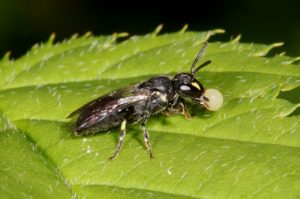The life cycle of the Common yellow-face bee (Hylaeus communis)
Certainly one of our smallest solitary bees the Common yellow face bee is only 4-5mm. BWARS described its nesting biology as “An opportunistic cavity-nester, utilising existing burrows of a suitable diameter, particularly in dead wood and woody stems (such as bramble), but also in the soil and crevices in mortar joints”. Falk goes a little further with a mention of hollow twigs, stems, and holes in dead wood, timber, walls and soil. So several years ago when I saw these in my garden I wondered where they were nesting and how to get them to not simply nest in my garden, I wanted to study them in more detail. I can honestly say they inspired me to make the summer unit, which has proved hugely successful for me and many other people, as well as many species of solitary bees and even solitary wasps!

Yellow-face bee blowing nectar bubbles to concentrate nectar by Ted Benton this is known as Water homeostasis
Depending upon temperatures, I have had females emerge in mid-May, with males a little earlier. The females forage on, hedgerow cranesbill and they use ‘fox and cubs’. However, they absolutely love Echium Blue Bedder as they obtain both nectar and pollen, albeit delicately from the little flower anthers. This flower is a smaller version of the wild Viper’s bugloss. These flowers are now a must-have in my garden which I purchase from Rosybee plants.
Although Falk states that they are attacked by Sapyga quinquepunctata, I have not seen them enter the nest cavities of these bees, even when they are inside the same units as other bees. I have seen them enter Red mason bee nests, (Osmia bicornis) and Blue mason bees, (O.caerulescens) and lay an egg inside their nesting cavities, next to the egg. He also mentions Gasteruption wasps, and I have to edit a cracking film I have made of Gasteruption jaculator egg-laying inside several common yellow-face bee cavities. The one in the film had her ovipositor nipped by the female bee and made a sharp exit!
Solitary Bees by Ted Benton I highly recommend
Steven Falk’s Field Guide to the Bees of Great Britain and Ireland is a must-have book if you want to ID bees and this extremely useful resource Steven Falk’s Flickr web site which furnishes extra photos and other useful resources to assist with identification.
With thanks to John Walters the artist and ecologist, for the bees mating clip, just rounded off this film nicely.
For more info about wild bees see BWARS

Thanks, that’s a grest film. I get these bees in my hotels & have watched the G. jaculator injecting eggs into their nests Can’t wait for the G. jac. video.
Hi Tim, its on my list! Cheers George